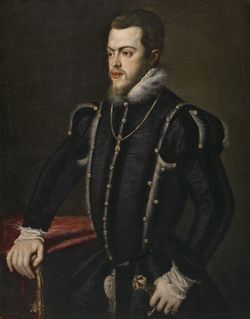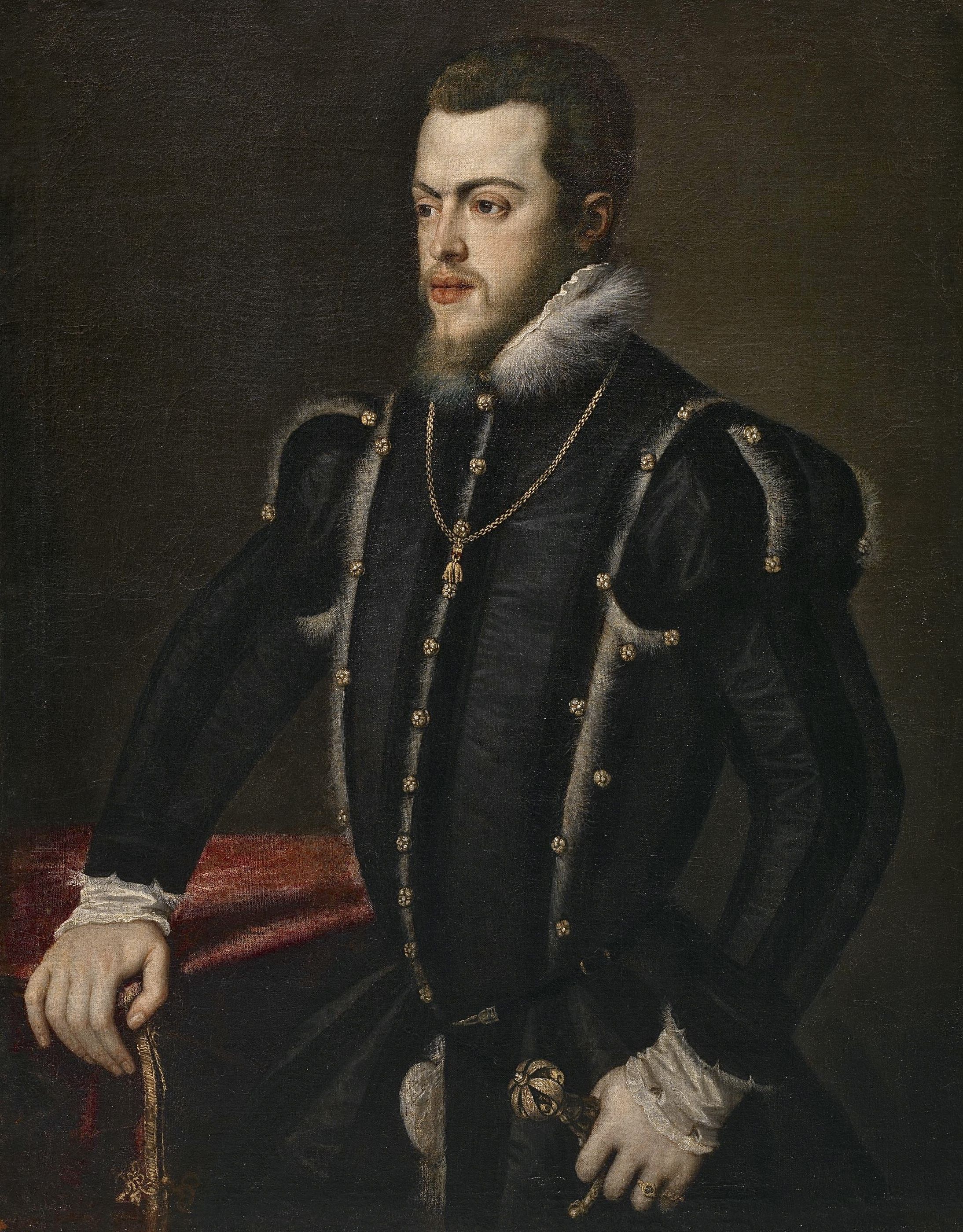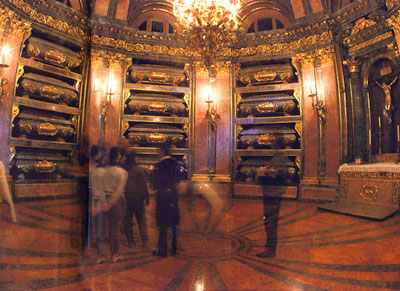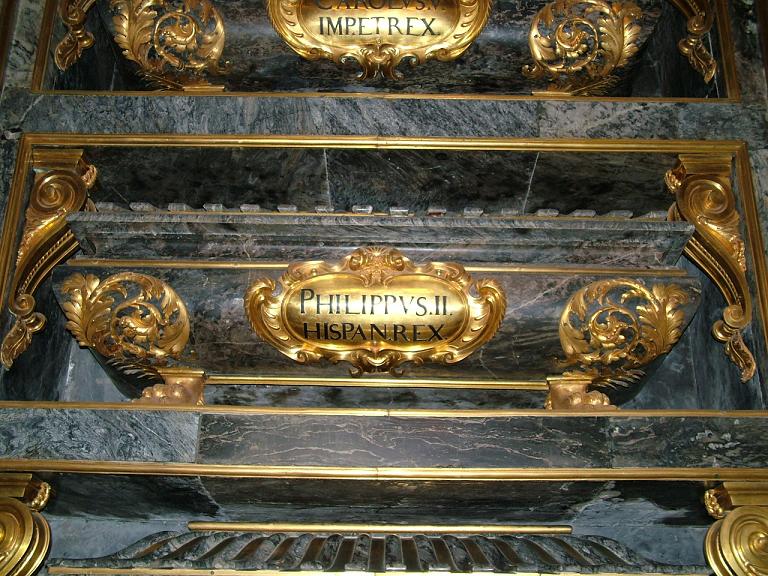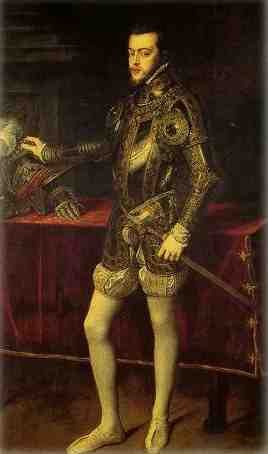He succeeded as King Felipe II de España in January 1544. Upon his marriage to Mary I of England in 1554, his father gave him the Kingdoms of Naples and Sicily. A purely political marriage on his part, he cared nothing for his bride, merely the opportunity to provide a Catholic heir to her kingdom. Not much more than a year after the marriage, he left the despised England and returned to Spain. Mary would see him only once more in 1557.
In 1555, his father ceded him the Low Countries and the crowns of Castille, Aragon, and Sicily. He set about imposing his brand of Catholicism on all his holdings. With Mary's death in 1558, he lost any influence he might have had in England and proposed marriage to his sister-in-law, Elizabeth I. No marriage took place. He became notorious for his distrust and suspicion of advisors and for running his kingdom through memoranda. His court became infamous for bitter factional fighting. He faced rebellion in Granada, Aragon, and the Netherlands. In the Low Countries, he defeated the French at Saint Quentin in 1557 and Gravelines in 1558 before signing the Peace of Cateau-Cambresis in April 1559.
After the Peace, he married a French bride, Elizabeth of Valois, who had initially been betrothed to his son. They had five daughters, two of whom survived to adulthood. She died in 1568. He mercilessly suppressed Protestantism in his holdings, finally eliminating it in Spain, stating in 1566, "I do not propose nor desire to be the ruler of heretics."
He married for a fourth time in 1570, Anna Erzherzogin von Österreich, who was the mother of six, but only one son survived childhood. He made good a claim on the Portuguese throne in 1580.
In 1588, he launched the Spanish Armada against England with the goal of re-establishing Catholicism there and in Holland. On July 28, the Spanish fleet of 130 vessels sailed up the Channel to defeat, beginning Spain's naval decline. He has been described as botth industrious and indecisive, pious and suspicious, devoted and cold.
Under his reign, Spain reached the zenith of its power; he is credited with ending French ambitions in Italy and the Netherlands, instituting settlements in the Philippine Islands, which were named for him; and he establishing the first Pacific trade route between America and Asia. He died at age 71, succeeded by his only surviving son, Felipe III.
He succeeded as King Felipe II de España in January 1544. Upon his marriage to Mary I of England in 1554, his father gave him the Kingdoms of Naples and Sicily. A purely political marriage on his part, he cared nothing for his bride, merely the opportunity to provide a Catholic heir to her kingdom. Not much more than a year after the marriage, he left the despised England and returned to Spain. Mary would see him only once more in 1557.
In 1555, his father ceded him the Low Countries and the crowns of Castille, Aragon, and Sicily. He set about imposing his brand of Catholicism on all his holdings. With Mary's death in 1558, he lost any influence he might have had in England and proposed marriage to his sister-in-law, Elizabeth I. No marriage took place. He became notorious for his distrust and suspicion of advisors and for running his kingdom through memoranda. His court became infamous for bitter factional fighting. He faced rebellion in Granada, Aragon, and the Netherlands. In the Low Countries, he defeated the French at Saint Quentin in 1557 and Gravelines in 1558 before signing the Peace of Cateau-Cambresis in April 1559.
After the Peace, he married a French bride, Elizabeth of Valois, who had initially been betrothed to his son. They had five daughters, two of whom survived to adulthood. She died in 1568. He mercilessly suppressed Protestantism in his holdings, finally eliminating it in Spain, stating in 1566, "I do not propose nor desire to be the ruler of heretics."
He married for a fourth time in 1570, Anna Erzherzogin von Österreich, who was the mother of six, but only one son survived childhood. He made good a claim on the Portuguese throne in 1580.
In 1588, he launched the Spanish Armada against England with the goal of re-establishing Catholicism there and in Holland. On July 28, the Spanish fleet of 130 vessels sailed up the Channel to defeat, beginning Spain's naval decline. He has been described as botth industrious and indecisive, pious and suspicious, devoted and cold.
Under his reign, Spain reached the zenith of its power; he is credited with ending French ambitions in Italy and the Netherlands, instituting settlements in the Philippine Islands, which were named for him; and he establishing the first Pacific trade route between America and Asia. He died at age 71, succeeded by his only surviving son, Felipe III.
Bio by: Iola
Family Members
Advertisement
See more Felipe II memorials in:
Records on Ancestry
Sponsored by Ancestry
Advertisement
